You are reading the older HTML site
Positive Feedback ISSUE
november/december 2007
Impressions: The Lamm M1.2 Reference
Monoblocks
by David W. Robinson
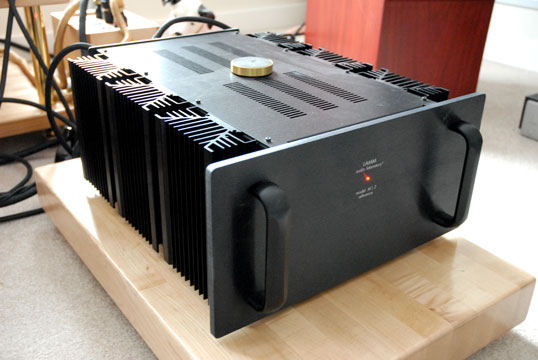
[All photographs and image processing by Robinson]
"You're going to like the Lamms."
Rick Gardner warned me about this. "You know, David" sez he, "I really think you're going to like these Lamm monoblocks. Very tasty…just the sort of thing for you." The good folks at Lamm Industries had sent a pair of their M1.2 Reference monoblocks to us in Oregon; Rick had gotten the first shot at them, while I was finishing out my (all too short) time with the magnificent Boulder 2060 stereo amp (https://positive-feedback.com/Issue27/2060_boulder.htm). After I was done, we shifted the Lamm M1.2's Ref up to River City to follow in the wake of the Boulder 2060.
This was not kind; what a tough act to follow.
But Rick and I know each other's taste in audio gear and sound pretty well. Generally, we agree on what's what in music and playback, and the sorts of things we might disagree on or debate are just what good friends will do: the degree of detail in fine audio; the role of tonal warmth in our listening rooms; where the boundary between euphony and you-phoney might be in the gear, the rooms, and the shows that we visit for PFO. Earth-shaking issues like that. Good audio friends are a treasure, and help you to stay alive and honest in the all-too-acrimonious world of audio.
Rick had also heard the 2060, though, and the fact that he was still recommending that I spend some time with the Lamm M1.2's caught my attention. I decided to give them a try.
Which, as it turned out, was the right decision…
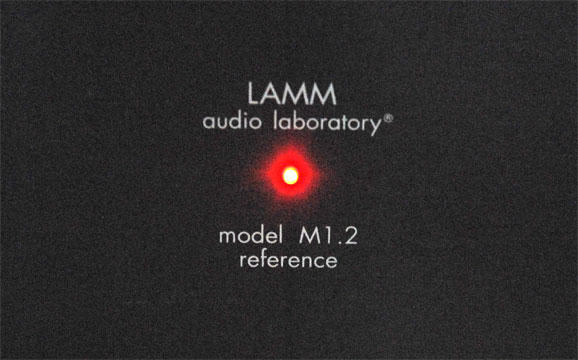
General technical description
The Lamm M1.2's Reference Monoblocks represent Lamm's current state-of-the-art product for hybrid operation, combining twelve high-speed MOSFETs in the output with a carefully selected 6922 tube in the second stage of the amplifier. The M1.2's monoblock is a no overall feedback design rated at a nominal 110-watts continuous of true pure Class A at either 4 or 8 Ohms (via switchable impedance on the chassis back), doubling to 220-watts continuous at 2 Ohms (low impedance setting) or 4 Ohms (high impedance setting; these doubled power ratings into halved impedance are not pure Class A, however). It will deliver 400-watts continuous at 1 Ohm (low impedance setting) or 600-watts continuous at 1 Ohm (high impedance setting). Peak power is listed at 450-watts (low impedance) to 700-watts (high impedance). This power rating puts it in the range that makes my Nova Rendition II speakers (with a low-middling 88dB/Watt/meter efficiency) reasonably happy. Since the Novas are a nominal 4 Ohm load (ranging down to 3 Ohms), I used the "1-6 Ohm" load setting on the back of the M1.2s. The other switch setting is "8-16 Ohms" for those who have speakers with higher impedance.
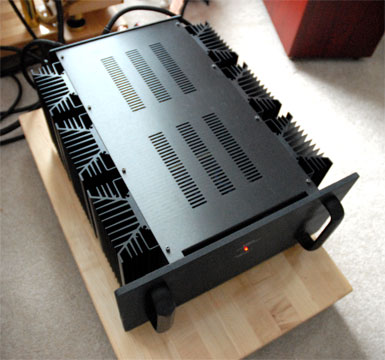
For those who'd like the technical highlights, I can summarize other specifications that I find to be helpful in broad strokes. Lamm lists nominal frequency response at a respectable 4Hz - 155kHz, +0dB/-3dB. The slew rate is listed at 33.5 Volts per microsecond, with nominal damping of 98 @ 8 Ohms. The size of the M1.2's Refs is 8.25" H x 17" W x 22.5" D (which includes front and rear handles—good-o!), with a weight that tilts the balance beam at a middling 68.5 pounds. For complete M1.2's Reference specifications, see the extensive set of parameters that Lamm lists on their site. Lamm has done an exemplary job with its specs here; I wish that every fine audio firm was so thorough with its technical information.
I hadn't had a hybrid amplifier in for review since the days Gilbert Leung's Blue Circle BC 2 monoblocks way back in the late 90s, at the recommendation of Stu McCreary. But that was ten years ago; how would Lamm's hybrid sound in my own listening room?
Right out of the box, I have to confess that my first visual take was that the Lamms were like any number of other monoblocks that I had listened to over the years: black; moderately, but not excessively, heavy; cooling fins on the sides; and handles on the front and rear. A red power LED up front. If you were just going on looks, you wouldn't see anything in the M1.2's Reference monoblocks that you would necessarily write home about—not at first glance, anyway.
A more careful inspection of the back of the Lamm, together with a reading of the documentation before I powered them up, however, changed my initial take on the M1.2. Clearly a great deal of effort had gone into the design, and intelligence was written all over a number of external features: soft-start power up. Locking power switches (pull OUT, then UP to power up; OUT, then DOWN to power off). Impedance switching, as described above, with matching OUT—then UP or DOWN—operation. The dual pair of hexagonal binding posts for bi-wiring are constructed of brass with gold coating. More importantly, they are sturdy and accessible with a crescent wrench, allowing you to really get a bit of torque on your cables. This is a good thing! (Designers/manufacturers who turn their binding posts into thumb screws and dissection stations for bleeding fingers are a real puzzlement; I sometimes wonder if they've actually bothered to use their components. Radical thought.) There are also gold plated XLR and RCAs inputs to handle either topology, which is always a handy thing.
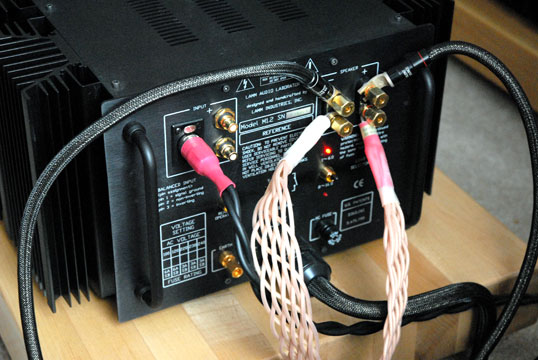
The back side of the M1.2's Reference, cabled as described below
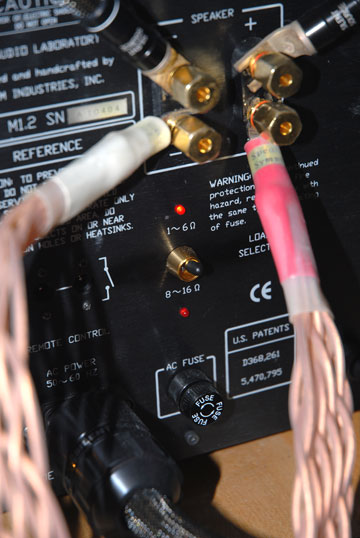
A close-up view of the impedance switch, which I set to the "1-6 Ohm" (low impedance) range; to toggle this, you pull OUT then either UP or DOWN, preventing accidents with your switch settings. Intelligent stuff.
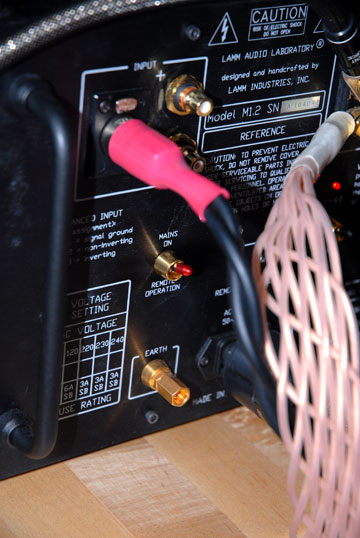
Another close-up, this time of the main power switch; like the impedance switch, operation requires that you pull OUT, then UP or DOWN to complete powering on or off. The "Earth" connector can be seen clearly, which is quite separate from the internal grounding.
Inside the chassis, the M1.2's Reference sports an array of quality components according to Lamm:
Each amplifier is carefully constructed and hand-crafted with the finest materials and parts currently available, some of which include military graded low noise DALE metal film resistors; PRC wire wound resistors; ELECTROCUBE and ROEDERSTEIN film capacitors; high frequency switching grade CORNELL DUBILIER electrolytic capacitors; BOURNS multi-turn potentiometers; HAMMOND filter chokes; military graded low noise long life vacuum tubes; high quality heavy duty gold-plated binding posts and RCA jacks; gold-plated NEUTRIC XLR connectors, and CAMAC-type coaxial connectors from FISCHER.
(I'm not sure why the references to potentiometers and coaxial connectors are included in the above list, unless the parts list applies to Lamm products generally.) Additionally, Lamm claims that the toroidal trannies used in the M1.2's Ref were carefully optimized for this design, and are internally isolated from the surrounding chassis for maximum vibration resistance.
So while the M1.2's may seem unprepossessing at first, they're clearly a very carefully designed, carefully crafted amplifier..
Setup
After going over the documentation, I decided to run in balanced mode using the EMM Labs DCC2 SE as my preamp for all digital sources, which were primarily (but not exclusively) SACDs. I placed the M1.2's on a pair of Walker Audio's superb Prologue Reference Amplifier Stands. My experience with the Walker stands is that they impart a real quickness, clarity and responsiveness to any amplifiers that are placed on them. I suspected that they would synergize with the Lamms very well—it turned out that they did.
Upstream, the sources that I used included the EMM Labs CDSD SE Transport and DCC2 SE DAC/preamp tandem, linked via ST fiber optic, and the Teac Esoteric DV-60 Universal Player (see my recent review elsewhere in this issue at https://positive-feedback.com/Issue34/dv60.htm). Power cabling was by JENA Labs to all components, and also for the XLR interconnects (Symphonies) from the DV-60 to the DCC2 SE. The DCC2 SE itself was powered by the exceptional JENA Labs Model One power cable. All were linked to the M1.2 during the first half of the review with a pair of EMM Labs Isopath XLR cables; during the second half of the review, connection was via a specially constructed, shielded pair of JENA Labs Gemini XLRs.
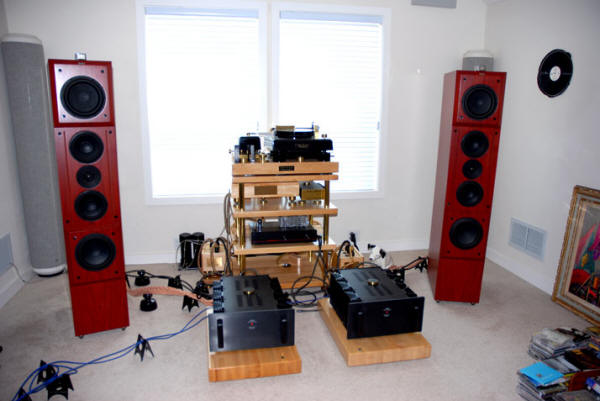
The M1.2's in place, as described in this section. The blue balanced cabling to the amplifiers are the EMM Labs Isopath XLRs.
Downstream, the M1.2 themselves were powered with a pair of Silent Source power cables which I've used with pleasant success this year. These were plugged into a pair of Walker Audio's Velocitor Power Line Enhancers (don't leave home without them!), each with its own dedicated 20 amp circuit. The bi-wiring of the Nova Rendition II speakers for this project was accomplished by using a pair of Silent Source speaker cables for the midrange/tweeter section, and a pair of JENA Labs Symphonies on the woofer section. All cables were suspended from direct contact with the floor using Dedicated Audio's handy-dandy Cable Towers (which have certainly made this task easier). As always with the Novas, a pair of Walker Audio's High Definition Links, Reference Edition, was used at the binding posts on the speaker end: one for the midrange/tweets, one on the woofer section. The final touch on the Novas was a pair of the Townshend Audio Supertweeters to handle the ultrasonics.
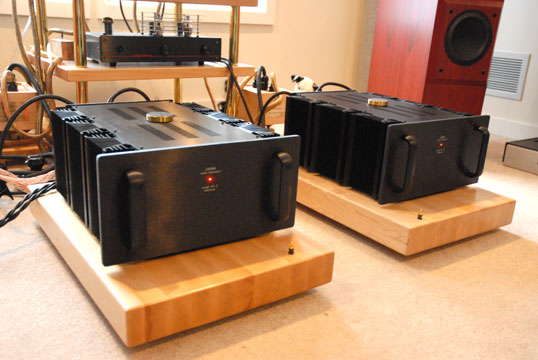
Listening notes…
My first impression of the M1.2's comprised listening sessions over at Dr. Sardonicus' place, as I noted in the introduction. These were very favorable, and decided me on continuing the project in my own listening room late last fall. The first few weeks were enough of an initial delight to allow me to present a Brutus Award to the M1.2's—just under the wire in 2006 (see https://positive-feedback.com/Issue28/gizmo.htmm).
In my comments from Issue 28, I said:
This was a surprise for me this year; I wasn't expecting to listen to any hybrid amplifiers, and frankly haven't done so since my days with the 75 watt Blue Circle monoblocks back in the later '90s. But my unindicted audio co-conspirator Dr. Sardonicus brought this one to my attention: "You ought to try these out, David; I really think you'll like them."
Sure enough, he was right …so much so that a Brutus Award that I wasn't expecting to give is definitely in order. Thee Lamm M1.2's Reference Hybrid Power Amplifier is a Pure Class A design rated at 110 watts per monoblock @ 8 ohm (high impedance setting) or 4 ohm (low impedance setting), 220-watts @ 2 ohm, and 400-watts into 1 ohm. While the M1.2's isn't the most powerful design on the planet, it combines musical richness and excellent detail with timbral rightness and surprising dynamics in a most compelling way.
How do I know these qualities? How can I be sure they're worthy of the mighty Brutus Award? Easy. Because I keep listening to the bloody things! In fact, I'm listening to the M1.2s (via the phenomenal Walker Audio Velocitors) being fed by the EMM Labs Signature Edition front end as I complete these awards. (The brand new Jacobs/Freiburger Barockorchester Handel's Messiah on Harmonia Mundi SACD, if you must know …a very fine performance and recording.) They may not do everything in the very best way, and they may not drive the most difficult loads with aplomb, but the M1.2s have a holistic rightness that satisfies at the level of the soul, and make me want to listen to music continually. And that's certainly not true of every amplifier that I've ever had in my listening room. On the contrary…
So congratulations to the folks at Lamm for a splendid achievement in the M1.2s. These are monoblocks that I could live with for quite a long time, believe me.
You have to be careful of what you say; words can come back to haunt you. A year ago, I said "that I could live with them for quite a long time…" Unlike most review projects, and due to the kindness and patience of the good folks at Lamm Industries, I've had the rare privilege to do an extended session with the M1.2's Refs. This meant that rather than rushing through a review in a couple of months, I spent the past year listening to the M1.2's Reference monoblocks. It provided the amplification for all of my reviews this year. This has given me a unique opportunity to appraise not only its sonic character, but also to see how reliable it was, how stable, and how it would respond to changes in source or other parameters like cabling.
Now that I had done so, had I been right? Or was my Brutus Award, given in haste, to be repented of at leisure??
Not hardly. Quite the contrary.

Instead, I found that the more I listened to the M1.2's, the more they grew on me. Nothing flashy or fancy; no sock-me-in-the-face Technicolor. Just loads of musical values that were very right, leading to long and satisfying listening over many months. And the more I listened, the more confirmed my initial impressions were.
A year ago, I had written that the sonic character of the M1.2's involved "…musical richness and excellent detail with timbral rightness and surprising dynamics…." A year later, I say, "Spot on!" I wouldn't change a thing in that initial appraisal. The Lamms involve an unusual blend of audio qualities. Usually you can draw a line between amplifiers that are "warm" or "lush," while at the other end of the tonal spectrum you have components that are "detailed and spacious" (with "analytical" being somewhere down the far end of the line). The M1.2's provide a fusion of these two qualities, combining a rich, resonant feel to the music without losing a fine sense of detail, space and transparency. The balance of these apparent opposites is a lovely achievement, and leads to tonal and textural harmony over time. High frequencies are nicely extended; the midrange properly proportioned; the bass frequencies deep, without tubbiness. Note that this was true with either the EMM Labs Isopath XLRs, or with the JENA Labs Gemini shielded XLRs, though the EMM Labs tended to emphasize the higher frequencies and airiness, while the JENA Labs had a more rounded presentation.
The dynamics of the M1.2's were surprising, given the fact that the Novas are not easy loads to drive, and that the dynamics of SACDs can be quite serious. The so-called micro-dynamics (low level, nuanced dynamic swings) were well resolved by the Lamms on all SACDs that I've listened to over the past year. (For a list of some of the key SACDs that I used with the M1.2s, see my review comments in the "Enough! How's it Sound?!" subsection on the Teac Esoteric DV-60, elsewhere in Issue 34 at https://positive-feedback.com/Issue34/dv60.htm.) In particular, just about any of the superlative Top Music SACDs …and I have just about all of them …shine gloriously with the M1.2's.
The sense of texture and timbre is highly tactile. You can close your eyes and feel Joe Weed's guitar strings on Joe Weed and the Vultures! Do yourself a favor—get this SACD and see why I'm so pleased with this phenomenal recording. The M1.2's excel in their rhythm and pacing, too. It doesn't take much to get your head nodding and your toe tapping while listening to them, regardless of the kind of music I was listening to. Bach benefited just as much as Beck did from the well integrated sense of rhythmic rightness.
Macro-dynamics and the sense of dynamic slewing were also generally excellent with the M1.2s. It's rare to have a 110-watts amplifier on 88dB/W/m speakers that puts such a surprising amount of slam into its presentation. While the M1.2's can be pressed to the wall (see my comments below), you have to work very hard to do it, and your speakers must be moderately difficult, as my Nova Rendition II's are.
Soundstaging and imaging are likewise excellent with the Lamms. At no point did I feel like my listening room was a big box; the M1.2's did what all superior amps must help you to do: keep your listening room walls at bay. Placement of instruments, and the sense of presentation boundaries were convincingly rendered, and all experienced listeners who have spent time in my room found the dimensionality to be quite satisfactory. In my listening room, only the Wavac HE-833 v1.3 and the Boulder 2060 did a better job of soundstaging (height/width/depth) than the M1.2's…but the price differential over the Lamm is substantial in both cases.
I do value transparency in fine audio over perhaps all other sonic values, since I am becoming convinced that it is fundamental to getting all other values right. In this dimension, the M1.2's Ref's exhibited fine performance; without losing any of their sense of resonant richness …like a fine guitar …the M1.2's had a sense of clarity and detail that kept their presentation from becoming closed in, or overly warm. Think: a clear sky, but with a tropical breeze. It's hard to describe this balance; it's both clear and richly musical, but the effect is extremely seductive. Think of a beautiful northern Italian woman…or a blond Brazilian woman …or a peppery Fuentes cigar with a great tawny Port. If that connects, then you know what I mean: that's the Lamm M1.2's Reference.
When you invest a significant sum in an audio component, you are naturally anxious that it be reliable. Usually it's tough to assess this quality, since most reviews are of relatively short duration. This time, however, with a year's experience under my belt, I can say that the reliability of the M1.2's was exceptional. There were no operational problems at all. No buzz. No hum. Not even a blown fuse. Just flawless operation. Things can go wrong, of course; but they never did with the Lamms …and remember that these review units had been to Doc S. before me, and who knows where before that.
As to stability, that ability to take a lickin' and keep on tickin', the M1.2's Refs did very well. The Nova Rendition II's, while not deeply nasty, represent a fairly challenging load. They are only moderately efficient at 88dB/W/m, and are a nominal 4 Ohms, dipping to 3 according to Nova USA. Their Scanspeak drivers always make for a musical experience, but they do make demands of their amplifiers. This is particularly true when I'm listening to favorite SACDs or LPs and forget myself, sometimes pumping the volume up to 105dBs for brief moments with the really good stuff—though I try not to be stupid too regularly. (How do I know the volume level? By using my handy Cen-Tech …the mark of a true audiophile. Audiophilia. It's a disease.)

Having said all this, only twice in a whole year of listening did I push the M1.2's to the point of overload, when their protective circuits caused them to mute with flashing LEDs for a few seconds while they recovered. (This is, by the way, a good sign that you need to get a grip.) Once was while I was listening to "Overture" on the MCA SACD of Tommy by The Who, which if you don't have this one, something's wrong with you, eh? Don't remember if it was the French Horns, the giant cymbal, or what, but it definitely caused the M1.2's to politely take a short break on one channel. I've done this in the past with the Linn Klimax monoblocks, too…nothing to be ashamed of. The M1.2's Ref's recovery was quite graceful. The second time this happened was no surprise at all: my SACD of Spitball's Pop Condition. This is a real rarity among SACDs, a disc that only briefly saw the light of distribution. Pure DSD European techno-rock, and dynamic as the infernal regions. One of the Lamm monoblocks decided to quietly check out of the amplification biz for a few seconds while playing the infamous first cut, "Underestimated." This is a track that is bloody well named, sports fans. It's also the track that caused the aforementioned Linn Klimax/Linn Komri tandem to go to overload protection a few years back. Think of it as the alt-rock generation's rough equivalent to Telarc's 1812 Overture, and you won't be far off. The fact that the Lamm monoblocks shrugged these events off quite gracefully represented outstanding performance in my estimation.
Apart from these two instances in an entire year, the M1.2's were just like the Energizer Bunny: they just kept going, and going, and going. And with a five year, non-transferrable warranty (not including the 6922 tubes, which have a two month warranty; see terms and conditions at http://www.lammindustries.com/warranty.html), the M1.2's have substantial backing just in case something does go wrong.
Are the Lamm M1.2's Ref without any nits to pick? No, there is a minor—and I stress "minor"—thing or two to keep in mind if you're considering the M1.2. First, if you have loudspeakers of moderate (or worse) efficiency …say, in the 86-87dB/W/m range, especially with nasty impedance behavior …you'll want to be aware of the fact that there will be limits to the power that can be delivered at the very bottom end, at low impedances, and at high (100+dB) SPLs. The M1.2's are remarkable for a 110-watts, pure Class A hybrid design, but they aren't a Boulder 2060. (Other than a 2060, what is?) My test of their robustness was extreme, though; I don't think that most users would press that hard, and if your speakers are in the 90-94dB/W/m efficiency range, I doubt that you'd ever have a problem. Not without deafness setting in first, anyway.
A second minor nit to keep in mind is that pushing the M1.2's hard without hitting any overload point can lead to just a touch of congestion, a distant suggestion that some compression is taking place. I only noticed this a few times, though. In retrospect, I think this may have been due to the fact that I was hearing the Lamms shortly after having the Boulder 2060 in my listening room. The 2060 is so utterly neutral and effortless …so completely transparent in my experience …that you tend to notice minor deviations like the tiny hints of congestion in the M1.2s by contrast. In all honesty, if I hadn't have spent some time with the 2060, I don't think that this nit with the M1.2's would have been noticed. Don't let it bother you, though; it certainly doesn't bother me.
Apart from these very minor items, I have no other nits to noodle. And that, my friends, is a very short list for twelve months of work.
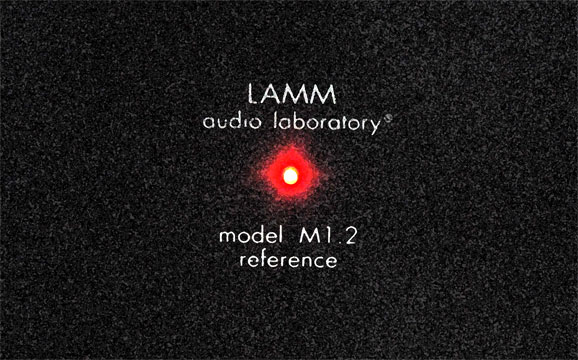
Conclusion
The Lamm M1.2's Reference monoblocks have been a superb companion in my listening room for the past year. Every review that I've done in 2007 has been done with these fine amplifiers doing the heavy lifting. They came in the door quietly, and, like "lovely Rita, meter maid," they've "towed my heart away." Unpretentious in appearance, but crafted with intelligence and deep insight into what makes for real joy in fine audio, the M1.2's Reference monoblocks are worthy of being added to my short list of the best amplifiers I've ever heard. They certainly the best hybrid amplifiers I've had in my listening room, ever. My heartiest congratulations to Vladimir Lamm and to his whole company; the M1.2's are a superlative audio achievement in every regard.
Furthermore, I can confirm my initial impressions of a year ago, and underline the Brutus Award that I gave these monoblocks in 2006. I should also say that I've made arrangements for the purchase of the review pair …I don't want to lose what I've had over the past year!
I give the Lamm Industries M1.2's Reference Monoblocks a "Ye Olde Editor's Very Highest Recommendation!"- with enthusiasm.
If you love music and the possibilities of fine audio, you will adore these amplifiers.
Lamm M1.2 Reference monoblock amplifiers
Retail: $21,690 (fall of 2007)
Lamm Industries, Inc.
2621 East 24th Street
Brooklyn, NY 11235 USA
TEL: 718. 368. 0181
web address:
www.lammindustries.com
email address:
[email protected]
